stop start Citroen C3 PICASSO 2014 1.G User Guide
[x] Cancel search | Manufacturer: CITROEN, Model Year: 2014, Model line: C3 PICASSO, Model: Citroen C3 PICASSO 2014 1.GPages: 292, PDF Size: 9.23 MB
Page 69 of 292

67
C3Picasso_en_Chap04_ouverture_ed01-2014
Fuel tank
Low fuel levelFilling
A label affixed to the inside of the flap reminds
you of the type of fuel to be used depending on
your engine.
When the low fuel level is reached
this warning lamp comes on in the
instrument panel. When it first comes
on there remains approximately
5 litres of fuel in the tank. To fill the tank safely:
F
t
he engine must be switched off,
F
o
pen the fuel filler flap,
F
i
nsert the key in the cap, then turn it to the
left,
F
r
emove the cap and hook it onto the clip
located on the inside of the flap,
F
f
ill the tank, but do not continue after the
3rd cut- off of the pump ; this could cause
malfunctions.
When you have filled the tank:
F
p
ut the cap back in place,
F
t
urn the key to the right, then remove it
from the cap,
F
c
lose the flap.
ad
ditions of fuel must be of at least
5
litres to be registered by the fuel
gauge.
The key cannot be removed from the
lock until the cap is refitted.
op
ening the filler cap may create a
noise caused by an inrush of air. This
vacuum is entirely normal and results
from the sealing of the fuel system. With Stop & Start, never refuel with the
system in STOP mode; you must switch
off the ignition with the key.
Fuel tank capacity: approximately 50 litres
(petrol) or 48 litres (Diesel); (Depending
on version: approximately 30 litres
(petrol or Diesel)). For the LPG version:
approximately 33 litres.
You must refuel as soon as possible to avoid
running out of fuel.
If you run out of fuel (
di
esel), refer also to the
"Checks" section.
4
access
Page 125 of 292
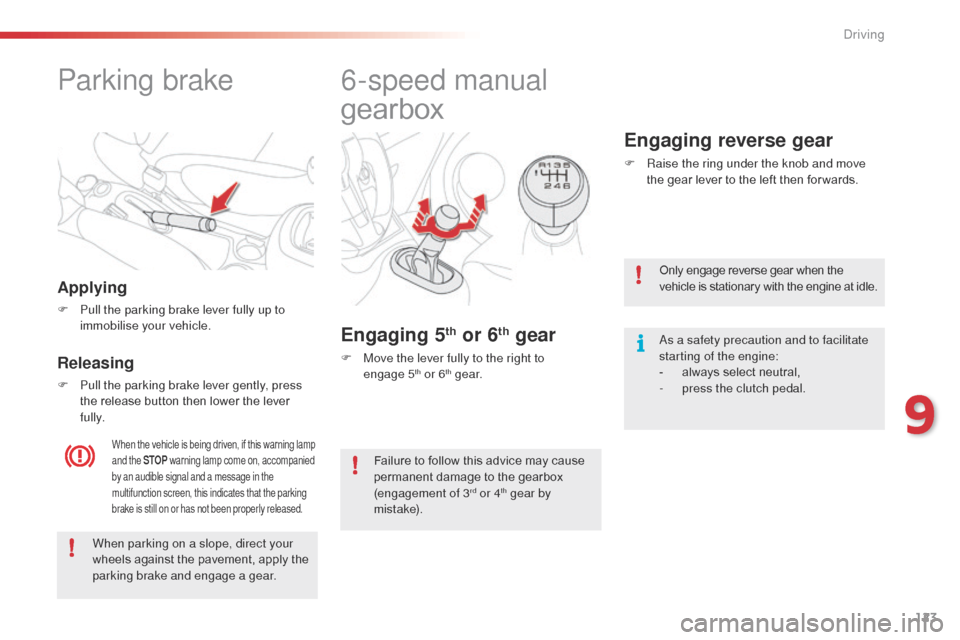
123
C3Picasso_en_Chap09_conduite_ed01-2014
Parking brake
Applying
F Pull the parking brake lever fully up to immobilise your vehicle.
When the vehicle is being driven, if this warning lamp
and the STOP warning lamp come on, accompanied
by an audible signal and a message in the
multifunction screen, this indicates that the parking
brake is still on or has not been properly released.
Releasing
F Pull the parking brake lever gently, press the release button then lower the lever
fully.
6-speed manual
gearbox
Engaging 5th or 6th gear
F Move the lever fully to the right to engage 5th or 6th g e a r.
Engaging reverse gear
F Raise the ring under the knob and move the gear lever to the left then for wards.
When parking on a slope, direct your
wheels against the pavement, apply the
parking brake and engage a gear. Only engage reverse gear when the
vehicle is stationary with the engine at idle.
as a s
afety precaution and to facilitate
starting of the engine:
-
a
lways select neutral,
-
p
ress the clutch pedal.
Failure to follow this advice may cause
permanent damage to the gearbox
(engagement of 3
rd or 4th gear by
m i st a ke).
9
driving
Page 132 of 292
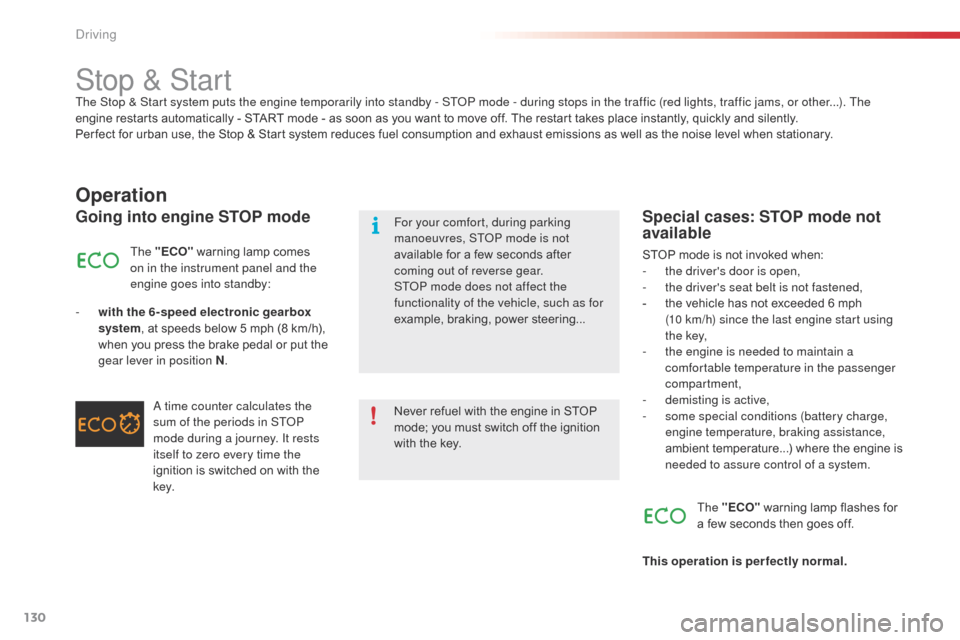
130
C3Picasso_en_Chap09_conduite_ed01-2014
Stop & StartThe Stop & Start system puts the engine temporarily into standby - SToP mode - during stops in the traffic (red lights, traffic jams, or other...). The
engine restarts automatically - START mode - as soon as you want to move off. The restart takes place instantly, quickly and silently.
Per fect for urban use, the Stop & Start system reduces fuel consumption and exhaust emissions as well as the noise level when stationary.
Operation
Going into engine STOP mode
The "ECO" warning lamp comes
on in the instrument panel and the
engine goes into standby:
-
w
ith the 6-speed electronic gearbox
system, at speeds below 5 mph (8 km/h),
when you press the brake pedal or put the
gear lever in position N .
a
time counter calculates the
sum of the periods in ST
oP
m
ode during a journey. It rests
itself to zero every time the
ignition is switched on with the
key.
Special cases: STOP mode not
available
STOP mode is not invoked when:
- t he driver's door is open,
-
t
he driver's seat belt is not fastened,
-
t
he vehicle has not exceeded 6 mph
(10
km/h) since the last engine start using
t h e key,
-
t
he engine is needed to maintain a
comfortable temperature in the passenger
compartment,
-
d
emisting is active,
-
s
ome special conditions (battery charge,
engine temperature, braking assistance,
ambient temperature...) where the engine is
needed to assure control of a system.
The "ECO" warning lamp flashes for
a few seconds then goes off.
This operation is perfectly normal.
Never refuel with the engine in STOP
mode; you must switch off the ignition
with the key. For your comfort, during parking
manoeuvres, ST
oP m
ode is not
available for a few seconds after
coming out of reverse gear.
ST
oP m
ode does not affect the
functionality of the vehicle, such as for
example, braking, power steering...
driving
Page 134 of 292
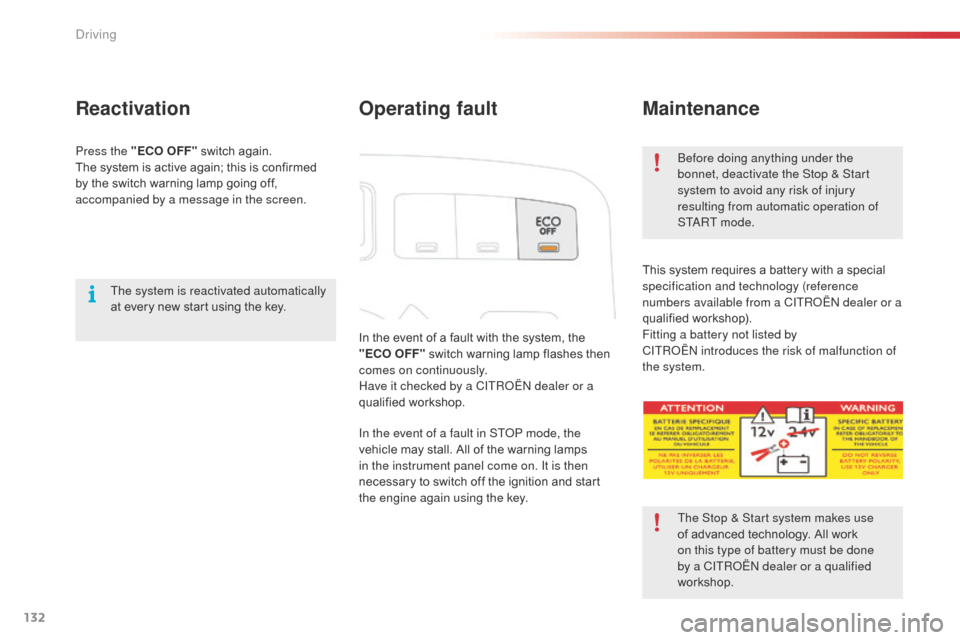
132
C3Picasso_en_Chap09_conduite_ed01-2014
Operating fault
In the event of a fault with the system, the
"ECO OFF" switch warning lamp flashes then
comes on continuously.
Have it checked by a CITR
o√čn
dealer or a
qualified workshop.
In the event of a fault in ST
oP m
ode, the
vehicle may stall. All of the warning lamps
in the instrument panel come on. It is then
necessary to switch off the ignition and start
the engine again using the key.
Maintenance
This system requires a battery with a special
specification and technology (reference
numbers available from a CITR
o√čn
dealer or a
qualified workshop).
Fitting a battery not listed by
CITR
o√čn
introduces the risk of malfunction of
the system.
be
fore doing anything under the
bonnet, deactivate the Stop & Start
system to avoid any risk of injury
resulting from automatic operation of
S T a
R
T m o d e .
The Stop & Start system makes use
of advanced technology. All work
on this type of battery must be done
by a CITR
o√čn
dealer or a qualified
workshop.
Press the "ECO OFF" switch again.
The system is active again; this is confirmed
by the switch warning lamp going off,
accompanied by a message in the screen.
The system is reactivated automatically
at every new start using the key.
Reactivation
driving
Page 143 of 292
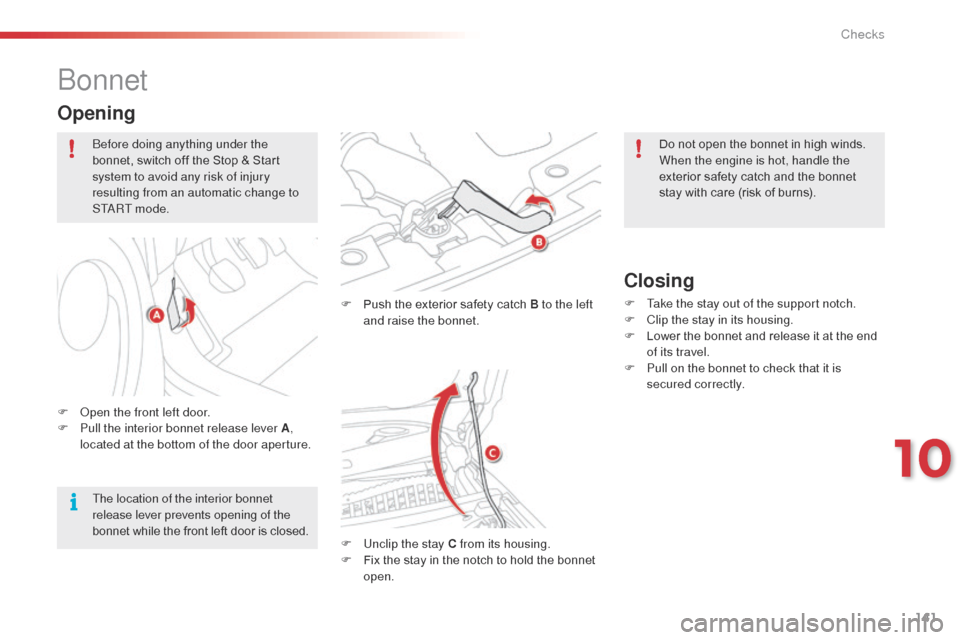
141
C3Picasso_en_Chap10_verification_ed01-2014
bonnet
F Push the exterior safety catch B to the left and raise the bonnet.
F
U
nclip the stay C from its housing.
F
F
ix the stay in the notch to hold the bonnet
open.
Closing
F Take the stay out of the support notch.
F C lip the stay in its housing.
F
L
ower the bonnet and release it at the end
of its travel.
F
P
ull on the bonnet to check that it is
secured correctly.
F
o
p
en the front left door.
F
P
ull the interior bonnet release lever A ,
located at the bottom of the door aperture.
Opening
before doing anything under the
bonnet, switch off the Stop & Start
system to avoid any risk of injury
resulting from an automatic change to
S T
a
R
T m o d e .
The location of the interior bonnet
release lever prevents opening of the
bonnet while the front left door is closed. Do not open the bonnet in high winds.
When the engine is hot, handle the
exterior safety catch and the bonnet
stay with care (risk of burns).
10
Checks
Page 150 of 292
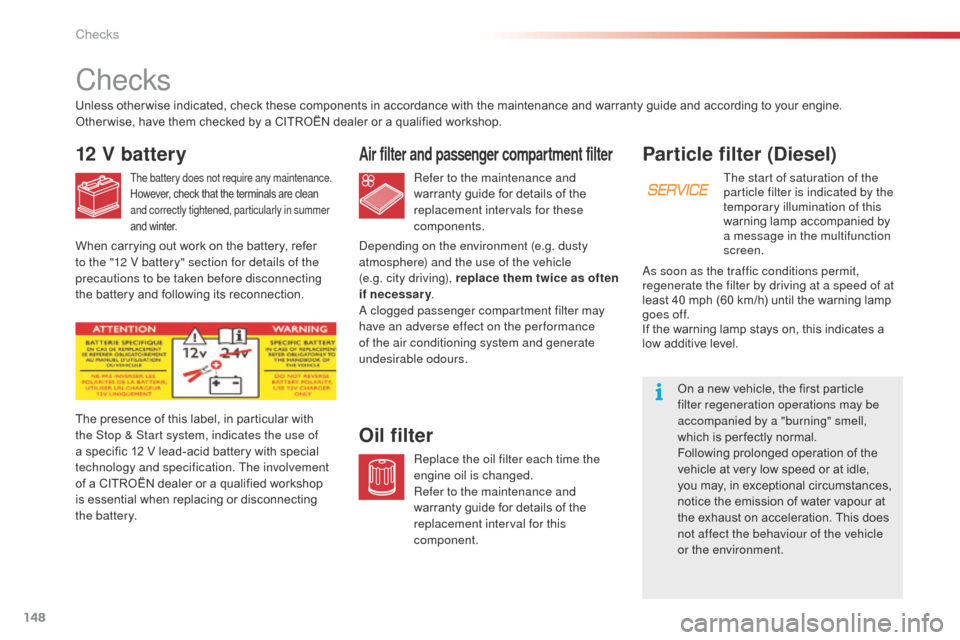
148
C3Picasso_en_Chap10_verification_ed01-2014
Particle filter (Diesel)
The start of saturation of the
particle filter is indicated by the
temporary illumination of this
warning lamp accompanied by
a message in the multifunction
screen.
On a new vehicle, the first particle
filter regeneration operations may be
accompanied by a "burning" smell,
which is per fectly normal.
Following prolonged operation of the
vehicle at very low speed or at idle,
you may, in exceptional circumstances,
notice the emission of water vapour at
the exhaust on acceleration. This does
not affect the behaviour of the vehicle
or the environment.
Checks
12 V battery
The battery does not require any maintenance.
However, check that the terminals are clean
and correctly tightened, particularly in summer
and winter.
Air filter and passenger compartment filter
Refer to the maintenance and
warranty guide for details of the
replacement intervals for these
components.
Oil filter
Replace the oil filter each time the
engine oil is changed.
Refer to the maintenance and
warranty guide for details of the
replacement interval for this
component.
Unless other wise indicated, check these components in accordance with the maintenance and warranty guide and according to your engine.
Other wise, have them checked by a CITRO√čN dealer or a qualified workshop.
When carrying out work on the battery, refer
to the "12 V battery" section for details of the
precautions to be taken before disconnecting
the battery and following its reconnection.
The presence of this label, in particular with
the Stop & Start system, indicates the use of
a specific 12 V lead-acid battery with special
technology and specification. The involvement
of a CITRO√čN dealer or a qualified workshop
is essential when replacing or disconnecting
the battery.
de
pending on the environment (e.g. dusty
atmosphere) and the use of the vehicle
(e.g. city driving), replace them twice as often
if necessary .
a c
logged passenger compartment filter may
have an adverse effect on the per formance
of the air conditioning system and generate
undesirable odours.
as s
oon as the traffic conditions permit,
regenerate the filter by driving at a speed of at
least 40 mph (60 km/h) until the warning lamp
goes off.
If the warning lamp stays on, this indicates a
low additive level.
Checks
Page 178 of 292
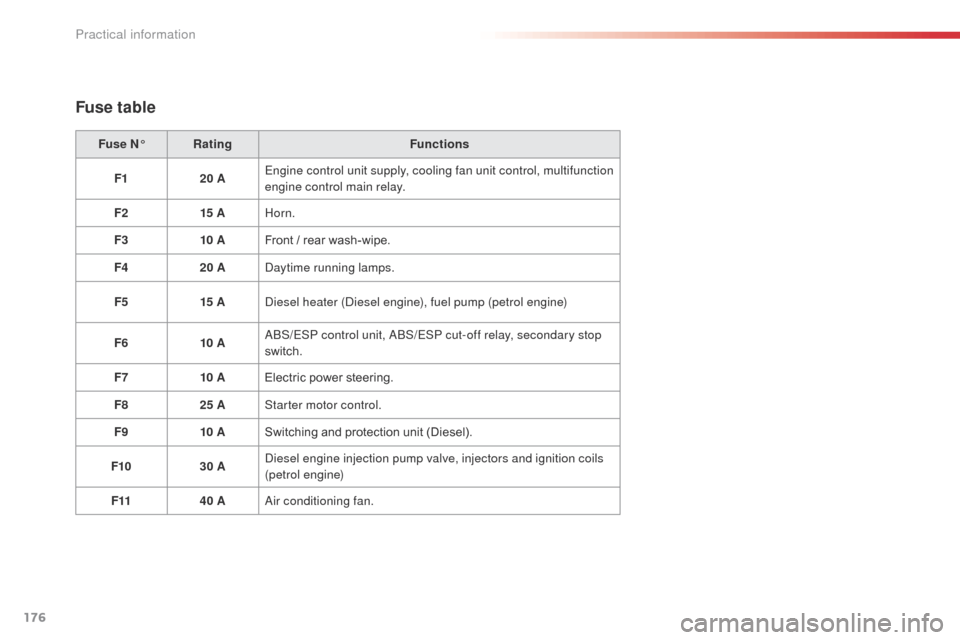
176
C3Picasso_en_Chap11_informations-pratiques_ed01-2014
Fuse table
Fuse N¬įRating Functions
F1 20 AEngine control unit supply, cooling fan unit control, multifunction
engine control main relay.
F2 15 AHorn.
F3 10 AFront / rear wash-wipe.
F4 20 A
da
ytime running lamps.
F5 15 A
di
esel heater (
di
esel engine), fuel pump (petrol engine)
F6 10 A
a
b
S
/ESP control unit, ab
S
/ESP cut-off relay, secondary stop
switch.
F7 10 AElectric power steering.
F8 25 AStarter motor control.
F9 10 ASwitching and protection unit (Diesel).
F10 30 A
di
esel engine injection pump valve, injectors and ignition coils
(petrol engine)
F11 40 A
air
conditioning fan.
Practical information
Page 181 of 292
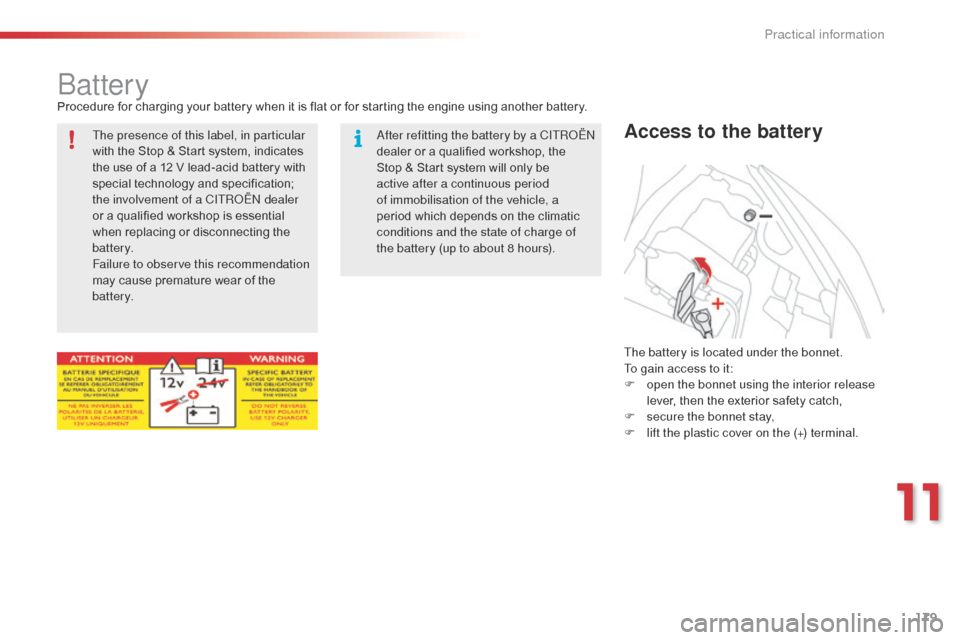
179
C3Picasso_en_Chap11_informations-pratiques_ed01-2014
batteryProcedure for charging your battery when it is flat or for starting the engine using another battery.
Access to the battery
The battery is located under the bonnet.
To gain access to it:
F
o
pen the bonnet using the interior release
lever, then the exterior safety catch,
F
s
ecure the bonnet stay,
F
l
ift the plastic cover on the (+) terminal.
The presence of this label, in particular
with the Stop & Start system, indicates
the use of a 12 V lead-acid battery with
special technology and specification;
the involvement of a CITR
o√čn
dealer
or a qualified workshop is essential
when replacing or disconnecting the
battery.
Failure to observe this recommendation
may cause premature wear of the
battery.
af
ter refitting the battery by a CITR
o√čn
dealer or a qualified workshop, the
Stop
& Start system will only be
active after a continuous period
of immobilisation of the vehicle, a
period which depends on the climatic
conditions and the state of charge of
the battery (up to about 8 hours).
11
Practical information
Page 184 of 292
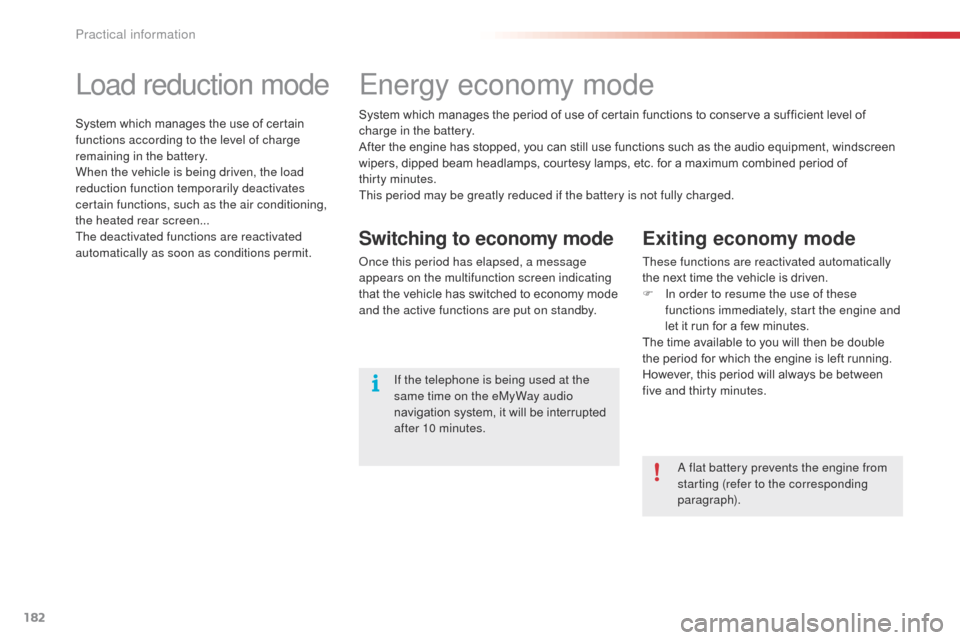
182
C3Picasso_en_Chap11_informations-pratiques_ed01-2014
Load reduction mode
System which manages the use of certain
functions according to the level of charge
remaining in the battery.
When the vehicle is being driven, the load
reduction function temporarily deactivates
certain functions, such as the air conditioning,
the heated rear screen...
The deactivated functions are reactivated
automatically as soon as conditions permit.
Energy economy mode
Exiting economy mode
These functions are reactivated automatically
the next time the vehicle is driven.
F
I
n order to resume the use of these
functions immediately, start the engine and
let it run for a few minutes.
The time available to you will then be double
the period for which the engine is left running.
However, this period will always be between
five and thirty minutes.
Switching to economy mode
once this period has elapsed, a message
appears on the multifunction screen indicating
that the vehicle has switched to economy mode
and the active functions are put on standby.
a
flat battery prevents the engine from
starting (refer to the corresponding
paragraph).
If the telephone is being used at the
same time on the eMyWay audio
navigation system, it will be interrupted
after 10 minutes.
System which manages the period of use of certain functions to conserve a sufficient level of
charge in the battery.
After the engine has stopped, you can still use functions such as the audio equipment,
windscreen
wipers, dipped beam headlamps, courtesy lamps, etc. for a maximum combined period of
thirty
minutes.
This period may be greatly reduced if the battery is not fully charged.
Practical information
Page 196 of 292
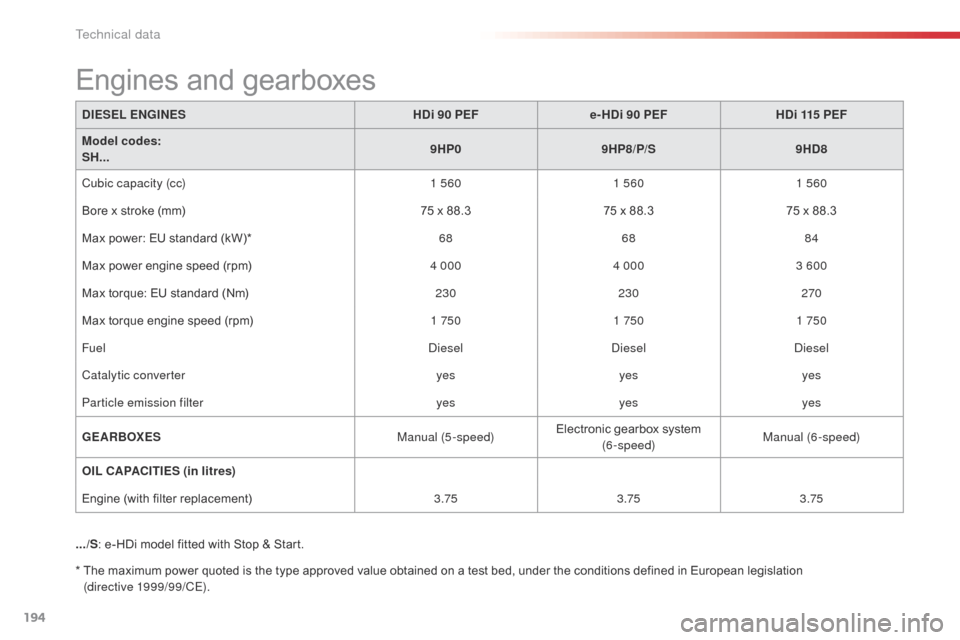
194
C3Picasso_en_Chap12_caracteristiques-techniques_ed01-2014
DIESEL ENGINESHDi 90 PEFe- HDi 90 PEF HDi 115 PEF
Model codes:
SH... 9HP0
9HP8/P/S 9HD8
Cubic capacity (cc) 1 5601 5601 560
Bore x stroke (mm) 75 x 88.375 x 88.375 x 88.3
Max power: EU standard (kW)* 686884
Max power engine speed (rpm) 4 0004 000 3 600
Max torque: EU standard (Nm) 230230 270
Max torque engine speed (rpm) 1 7501 7501 750
Fuel
die
sel
die
sel
die
sel
Catalytic converter yesyesyes
Particle emission filter yesyesyes
GEARBOXES Manual (5-speed)Electronic gearbox system
(6-speed) Manual (6-speed)
OIL CAPACITIES (in litres)
Engine (with filter replacement) 3.753.753.75
.../S : e-HDi model fitted with Stop & Start.
Engines and gearboxes
* The maximum power quoted is the type approved value obtained on a test bed, under the conditions defined in European legislation
(directive 1999/99/CE).
Technical data